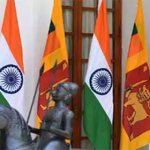Sri Lankan President Ranil Wickremesinghe’s visit to India on 21 July 2023 concluded with an ambitious agenda for bilateral connectivity. The visit was another step in the new partnership that India began with Sri Lanka in 2022, but forging closer economic ties will require fostering supply chains, a comprehensive free trade agreement and greater central bank cooperation.
The joint statement issued after the meeting clearly emphasised the economic element of the bilateral relationship. In the past, India’s security concerns over China’s role in Sri Lanka, disputes over fisheries and the unresolved issue of ethnic reconciliation have held back bilateral economic cooperation. But India played a crucial ‘Neighbourhood First’ role with foreign aid of US$4 billion to Sri Lanka after the island economy defaulted on its foreign debt in April 2022 and slipped into an economic crisis.
This time, it is not just a government-to-government plan. The partnership encourages investment from India’s private sector and joint ventures with Sri Lankan companies. Three areas — logistics, energy and tourism — are the focus of this partnership. This includes improving regional logistics and the development of ports in Colombo, Trincomalee and Kankesanthurai, ferry services between Indian and Sri Lankan ports and greater air connectivity between both countries. These are business investments that also enable people-to-people movement.
Bilateral energy engagement is significant. The most important projects include proposals to build an oil pipeline from India to Sri Lanka and to connect the two countries’ electricity grids. India already has oil pipelines and power links with Bangladesh and Nepal — providing a template that can be used with Sri Lanka. While India is an energy importer it houses a world-class and world-scale oil refining and processing industry.
Connecting Sri Lanka to the Indian oil grid will provide Sri Lanka with cheaper fuel, on account of India’s economies of scale. Sri Lanka’s fuel shortages, as seen in 2022 due to low foreign exchange reserves, may be mitigated. If Indian oil can be paid in Indian rupees, it may lower exchange costs and facilitate trade credits.
Connecting the power grids will also be potentially transformative. India’s electricity is among the cheapest in the world due to its reliance on domestically produced coal and local know-how. Reliable and affordable Indian power can help Sri Lanka overcome electricity shortages and develop its own wind energy trade potential. This clean but intermittent electricity can then be exported to the Indian power grid.
Sri Lanka is also looking to leverage India’s highly regarded, open-source digital public infrastructure, which helps to deliver essential government services digitally. By using the Indian rupee to settle bilateral trade and operationalising India’s Unified Payment Interface, digital payment in rupees can be used for small businesses and visitors in Sri Lanka.
The take-off has begun, but to truly integrate bilateral trade, three other business-oriented alignments must now be pursued.
First is to integrate Sri Lanka into India’s emerging supply chain framework. South Asian countries have lower hourly wages than China. But like China, South Asian businesses are flexible and willing to work with small orders. To compete, South Asia now needs to lower the high trade costs currently hampering businesses by pursuing more trade openness, improved regional trade and transport-related infrastructure and streamlining behind-the-border regulations. Once reforms are implemented, South Asia could develop regional industrial clusters and export processing zones along a well-oiled supply chain.
Globalising Sri Lankan firms should invest in South Indian states. Firms like Brandix should invest in textiles, Dilmah in tea and tourism and John Keels Holdings in food processing and tourism. India and Sri Lanka should actively promote bilateral foreign direct investment flows by improving their marketing to investors, liberalising FDI entry regulations and cutting red tape through digitisation.
Initiating early resumption of talks on the Economic and Technology Co-operation Agreement to promote regional rules-based trade and FDI would be important too. The aim should be a high-standard trade deal to facilitate deeper integration through supply chains and trade in services by adopting so-called 21st century trade rules.
Both countries now realise they have more to win from trade facilitation measures. These include transportation and infrastructure investments, a proposed land bridge and logistics and regulatory harmonisation. The asymmetrical economic strength of India and Sri Lanka needs to be factored into negotiations to prevent backlash from losing sectors and small firms in Sri Lanka.
Improved central bank cooperation is also crucial. Frequent meetings between central bank officials of India and Sri Lanka and an early warning system for economic crises are necessary. After the Asian Financial Crisis of 1997, ASEAN adopted a mutual monitoring mechanism to detect early warning signs, alert others of potential crises and assist each other. India and Sri Lanka can work on a bilateral system, whose template can be regionalised to the rest of South Asia.
Another area is an enhanced International Monetary Fund (IMF) Capacity Building programme. The IMF Training and Technical Assistance Center for Economic Capacity Building in South Asia is located in Delhi. With Indian aid, it can be expanded to provide increased training on macroeconomic management and financial stability. Such institutional mechanisms are key to regional stability.
The Modi–Wickremesinghe talks laid the foundation for a new direction in India and Sri Lanka, based on closer business-to-business ties encouraged by both governments. The experience of East Asia shows that market-led regionalism is the pragmatic way forward to achieve prosperity and growth.
Dr. Ganeshan Wignaraja is Professorial Fellow in Economics and Trade, Gateway House.
Manjeet Kripalani is Executive Director, Gateway House.
This article was first published in the East Asia Forum.


